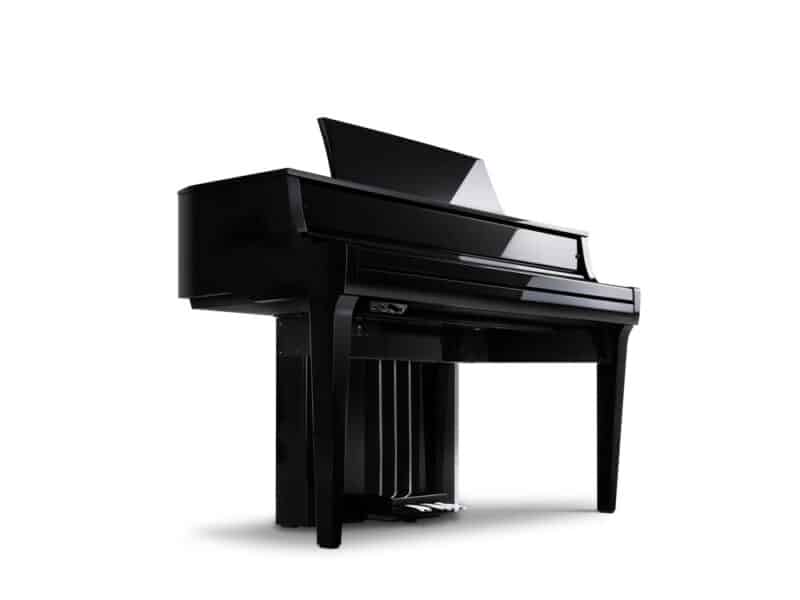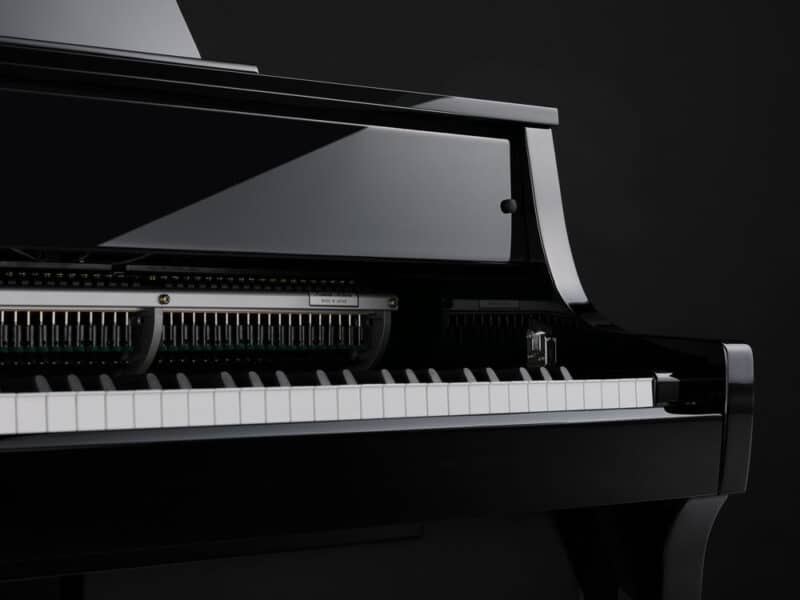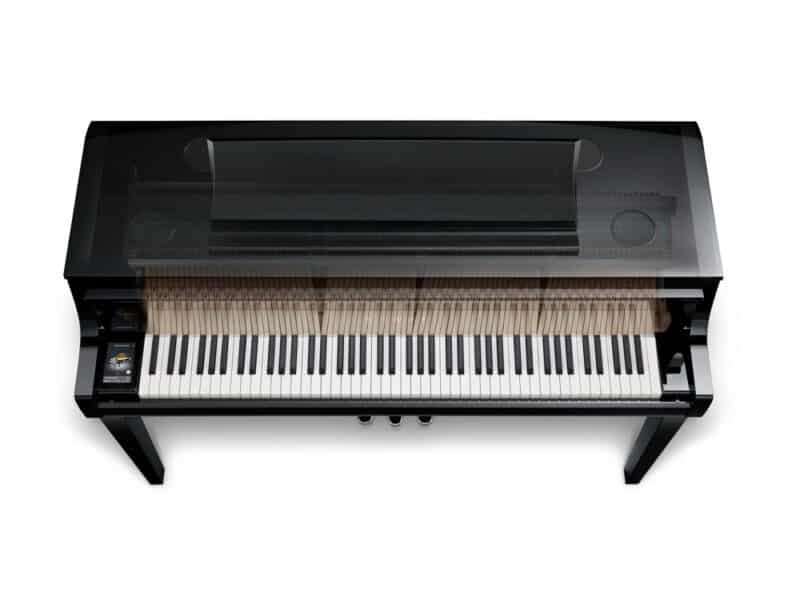Hybrid pianos are a relatively new addition to the market in recent years and are becoming increasingly popular among players due to their substantial musical potential. Yamaha and Kawai have been the two leaders in this field, which is probably largely owing to the fact that these two companies happen to be among the top acoustic piano manufacturers in the world.
The Kawai Novus NV10S, and Yamaha’s N1X Hybrid Avant Grand, are some of the nicest hybrid digital pianos currently in production, and both serve as the first point in which grand piano actions are offered in Kawai and Yamaha’s digital piano lineups. The N1X shouldn’t be confused with the NU1X which is the upright piano version, like the NV5S with Kawai.
We’re going to compare these two top-of-the-line hybrid instruments side-by-side and really dissect how they compare. Odds are many people shopping for a piano in this category will spend at least some amount on research given the substantial cost investment, so we hope a side-by-side comparison will be a nice compliment to anyone who finds themselves in research mode.
Yamaha N1X vs Kawai NV10s – Background

Undoubtedly some of you reading or watching at home will be asking why we’re comparing these specific two instruments because the Novus NV10S hybrid costs quite a bit more than the Yamaha N1X. It’s very fair to wonder if this is even a fair comparison.
Despite the price difference, the fact of the matter is that these are the most compared Hybrid pianos by search volume according to Google. We used several tools to validate this, and nothing came even close to the search volume that we found when we were researching NV10S vs N1X.
So, is this truly an apples-to-apples comparison? Not exactly given the price difference, so the conversation shifts to being centered around whether the NV10S is justifiably worth the extra dollars. And we think there’s good reason as to why these two pianos are so often compared by shoppers.
Why This Comparison Still Makes Sense
Both of these instruments use their respective companies’ flagship tone engines, which are built around their acoustic 9-foot concert grands with several layers of added digital enhancements in the form of resonance engines.
The goal of both Yamaha and Kawai is to deliver the very best nine-foot concert grand tonal simulation possible, in digital form with a much smaller physical footprint than a grand piano would normally occupy.
Secondly, both pianos offer an acoustic grand piano action, and it’s the lowest price point you get an acoustic grand piano action with hybrid technology from either manufacturer. Kawai’s CA series and the Yamaha Clavinova series pianos ultimately offer great actions, but they aren’t true acoustic piano actions.
This is the single biggest factor that’s going to draw people to either of these instruments and despite some other differences, the biggest reason they are inevitably compared.
Let’s move to a closer look at each piano’s sound system.
Piano Sound
Kawai’s SK-EX Rendering Sound Engine & Harmonic Imaging XL
The NV10S features the SK-EX Rendering Engine, which uses an 88-key multi-channel sampling of their flagship Shigeru Kawai SK-EX concert grand piano. Multi-channel means the piano was recorded with many microphones in different positions and configurations, and you’re then given 10 different preset configurations to choose from.
Rendering refers to the Resonance Modelling component of the sound, which is added synthesis of things like Damper Resonance and String Resonance. Courtesy of the Virtual Technician feature, you have access to 21 adjustable parameters to really refine the sound to your liking.
The NV10S is also equipped with Kawai’s more conventional Harmonic Imaging XL engine (HIXL) which offers 88-key stereo samples of the SKEX, EX and SK5 grand pianos with 256 note polyphony while covering all non-acoustic piano tones of which there are 90 total sounds.
Musical Impressions
Something that really stands out about the Rendering engine is the fantastic sense of the sound stage, which essentially refers to the 3D space that envelopes the sound making it seem like you’re actually in front of a grand piano.
When we get up into the top range of an acoustic SKEX Kawai piano, the treble comes across as sounding very thick. There’s just so much substance around the attack of the note, which is sonic behavior often associated with great 9-foot Steinways. This impression is totally present here with the NV10S.
In general, the sound is also very colorful and dynamic with a very wide range of possible expressions, which again, is the case with acoustic SKEXs.
Yamaha’s Spatial Acoustic Sampling
The Yamaha Avantgrand N1X is equipped with Yamaha’s Spatial Acoustic Sampling engine which features a similar approach to the NV10S. A Yamaha CFX concert grand piano, as well as a Bosendorfer Imperial, were sampled in four different positions relative to the soundboard to produce the basis for this sample, and from there, Yamaha’s Virtual Resonance Modeling (VRM) was added to fill in the sound.
Yamaha has also provided a version of the CFX with Binaural Sampling which offers a different piano experience, but the real highlight is definitely the Spatial Acoustic Sampling.
Polyphony is strong at 256 notes, though the total number of sounds is somewhat limited at only 15, which is a decision Yamaha has made with all of the Avantgrand pianos having anywhere from 5 to 15 sounds.
Rounding out the N1X is Yamaha’s Intelligent Acoustic Control (IAC) which automatically EQs the sound at certain playing volumes.
Musical Impressions
The N1X has a very clear bass tone, and as you move into the mid-range, the tone comes across as sounding very tight, even if you turn up the ambience to max.
There’s a difference between digital reverb and an actual 3D sense of space, and the N1X pulls it off to an extent as well, but not as convincingly as the NV10S. The treble on here is a little cleaner than the NV10S, but also thinner sounding.
Frankly, having the option of choosing between these two world-class instruments and their approaches to sound is quite a luxury.
That said, there are some interesting and meaningful differences, and for us, the thing that stands out is that the NV10S ultimately does sound more like you’re behind a real piano, able to perceive things like the hammers moving, the dampers, etc.
Now let’s take a quick look at their respective speaker systems.
Speakers
Both pianos boast a premium speaker array. Yamaha calls their the Spatial Acoustic Speaker System as a way to tie in the nomenclature with the sound engine.
The SAS system consists of 6 total speakers – a combination of tweeters, mid-range speakers and a woofer, with each frequency band being given its own amplifier to prevent interference. The rated power output is an eye-popping 180 watts of power.
Kawai doesn’t have any special branding for their speakers other than calling it a high-fidelity system, but it actually consists of 7 speakers in total – 4 top speakers, 2 dome tweeters and a woofer. The rated power output is only 130 watts, but playing them side-by-side, the NV10S actually gets significantly louder than the N1X, and has a much fuller presence, particularly in the bass register thanks to its unique amplification technologies.
On the other hand, we do feel like the NV10S requires a tiny bit of tweaking in the settings out of the box to optimize the speaker performance, while the N1X plays optimally right away.
Kawai also likes to advertise the inclusion of certain audiophile technologies such as 1-bit audio processing, dual DAC signal conversion and Onkyo’s DIRDC filtering.
Both pianos offer separate headphone amplifiers to optimize the headphone playing experience.
Piano Action

Yamaha’s Specialized Grand Piano Action vs Kawai’s Millennium III Hybrid Grand Piano Action
Despite both pianos boasting grand piano actions with wooden keys, the differences in feel between the two are actually very significant.
On the NV10S and its Hybrid grand piano keyboard action, there’s a sense that you’re playing a much larger piano – something in the 7 to 9-foot range. While this isn’t automatically a good thing due to personal preference, many pianists will look at this as a positive.
There are a couple of reasons why the action makes the NV10S feel like a larger piano. For one, the pivot length and overall key stick length on the NV10S’s action are longer than the action of the N1X. A longer key stick and pivot length creates the feeling of playing a larger piano and also offers players a deeper sense of control and nuance while producing faster and more consistent repetition speed.
Secondly, Kawai also equips the keys with a damper simulator, whereas Yamaha does not, and this also affects the overall perception of weighting on the instrument.
Both actions use non-contact optical hammer sensors (Kawai calls theirs IHSS) to measure the speed and force of the keys, resulting in a very accurate dynamic output. Optical sensors are currently the most advanced
So, like sound, this is an area where both pianos offer industry-leading specs, and while the NV10S boasts a more impressive action on paper, personal preference will rule the day.
Features/Connectivity/Cabinetry
Moving over to features and functionality and more outright gaps start to appear. This area is pretty clearly where Kawai is hoping people will be able to justify the price difference between these two instruments.
User Interface
The NV10S boasts what is essentially an Android-powered LCD touchscreen display surface which provides the user with full access to every aspect of the instrument’s functions and features. Navigating this touchscreen is just like operating a smartphone.
The N1X by contrast uses a more basic cheek-block control interface, which while functional, certainly pales in comparison to what Kawai is offering.
Features

The NV10S is equipped with a ton of preloaded music, consisting of demo songs, piano music, concert magic, and a whole bunch of lesson music including repertoire from Bach and Chopin.
Both pianos have USB MIDI and Audio recorders (WAV) with playback options, but the NV10S is quite a bit more extensive in this regard with the ability to overdub and even lets you do Bluetooth Audio recording.
Staples like a metronome, transpose and split is available on both pianos.
Connectivity
The connectivity differences between these two instruments also differ. Both pianos have dual headphone jacks, MIDI In and Out, 1/4” L/MONO, R line out, 1/8” line in, USB to Host (USB flash drive) and USB to Device.
Where they differ is that the NV10S keeps the line outputs separate from the headphones so you have an independent speaker control. There’s also a separate volume control for the line in as well.
Finally, the N1X curiously doesn’t offer anything in the way of Bluetooth connectivity, so to access the excellent Smart Pianist app you’ll have to either add a Bluetooth adapter and a WIFI connection or use a cabled connection.
The NV10S by contrast includes both Bluetooth MIDI and Bluetooth Audio without the need for an adapter so you can connect to smart devices wirelessly right away to access apps like Kawai’s PianoRemote.
Cabinetry
Both new pianos boast sleek, modern cabinets that don’t take up a ton of space and are built to go up against a wall and are available in Ebony Polish. Neither piano really captures the aesthetic of a digital grand, though they both look great.
Both feature an elegant music rest, as well as soft-close or soft-fall fallboards and a 3-pedal system consisting of soft, sostenuto and damper pedals, however, the NV10S uses a real grand piano damper mechanism for added realism.
Closing Thoughts
To summarize our comparison, the N1X ultimately plays, feels and sounds like a smaller piano – approximately 5’5” or so. It’s very well designed and very well executed.
The NV10S sound and feels like a much larger grand piano. For people who are used to or simply looking for a larger grand piano experience, the NV10S is very likely to be your hands-down preference.
If the N1X sounds good enough or even more satisfying and you’re not worried about extra sounds, or features of Bluetooth, it suddenly looks like the piano you’ll be taking to the checkout.
So, is the NV10S worth the extra money? For many people, the answer will be yes, but that’s not the case for everyone seeking a fine digital instrument.

